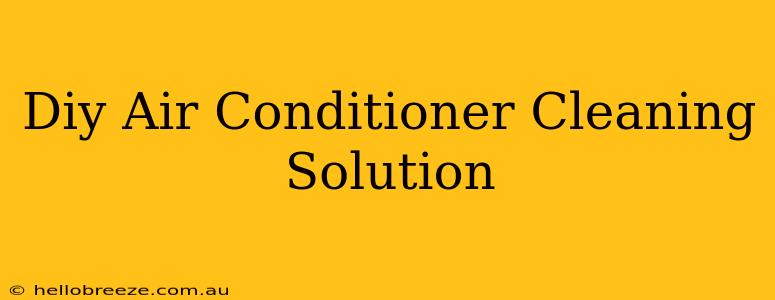Is your air conditioner blowing hot air instead of cool, or perhaps emitting strange odors? A dirty air conditioner can significantly reduce its efficiency and even impact your indoor air quality. Before calling a professional, consider tackling the problem yourself with a simple and effective DIY air conditioner cleaning solution. This guide will walk you through the process, ensuring your AC runs smoothly and efficiently all summer long.
Why Clean Your Air Conditioner?
Regular cleaning of your air conditioner is crucial for several reasons:
- Improved Efficiency: A clogged air conditioner has to work harder to cool your space, leading to increased energy consumption and higher electricity bills. Cleaning removes dust and debris, allowing for optimal airflow and energy savings.
- Enhanced Air Quality: Dirty air conditioners can harbor mold, mildew, and bacteria, which can be blown into your home, potentially triggering allergies or respiratory problems. Cleaning helps eliminate these harmful contaminants and improve your indoor air quality.
- Extended Lifespan: Regular maintenance, including cleaning, significantly extends the lifespan of your air conditioner. By removing obstructions and preventing damage, you can avoid costly repairs or replacements down the line.
- Preventative Maintenance: Cleaning your AC unit regularly is a simple form of preventative maintenance. This proactive approach helps catch minor issues before they escalate into major problems.
Making Your DIY Air Conditioner Cleaning Solution
You don't need expensive commercial products to clean your air conditioner. A simple, effective, and environmentally friendly DIY solution can be made using readily available household items:
- Warm Water: The foundation of your cleaning solution. Use warm, not hot, water to avoid damaging any components.
- Mild Dish Soap: A few drops of mild dish soap will help to cut through grease and grime. Avoid harsh chemicals that could damage your AC unit.
- White Vinegar: A natural disinfectant and degreaser, white vinegar helps to eliminate mold, mildew, and bacteria. A 50/50 mixture of water and vinegar is ideal.
Optional additions:
- Baking Soda: A natural deodorizer that can help eliminate unpleasant smells.
- Bleach (use cautiously): Only use diluted bleach as a last resort for stubborn mold or mildew. Always follow safety precautions and wear protective gear when handling bleach.
Step-by-Step Cleaning Guide
Remember to always disconnect the power to your air conditioner before beginning the cleaning process. Safety should be your top priority.
- Gather your supplies: Prepare your DIY cleaning solution, brushes, cloths, and a vacuum cleaner with a brush attachment.
- Remove the air filter: Carefully remove the air filter and clean it separately using warm, soapy water. Allow it to air dry completely before reinstalling.
- Clean the fins: Gently use a soft brush or a fin comb to remove dust and debris from the condenser fins. Be careful not to bend the fins.
- Apply your cleaning solution: Using a spray bottle, carefully apply your cleaning solution to the coils and other components. Let it sit for a few minutes to loosen dirt and grime.
- Rinse thoroughly: Use a garden hose (low pressure) to rinse away the cleaning solution. Ensure all soap residue is removed. Let the unit air dry completely before reconnecting the power.
- Clean the drain line: Locate the drain line and use a small brush or pipe cleaner to remove any clogs.
Maintaining a Clean Air Conditioner
Regular cleaning is key to maintaining a healthy and efficient air conditioner. Aim to clean your air conditioner's filters every 1-3 months, and perform a more thorough cleaning once or twice a year, depending on usage and environmental conditions.
By following these simple steps and using your own DIY air conditioner cleaning solution, you can keep your air conditioner running smoothly, efficiently, and extend its lifespan for years to come. Remember always prioritize safety and refer to your air conditioner's manual for specific cleaning instructions.

